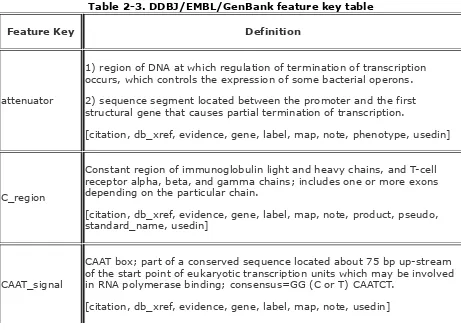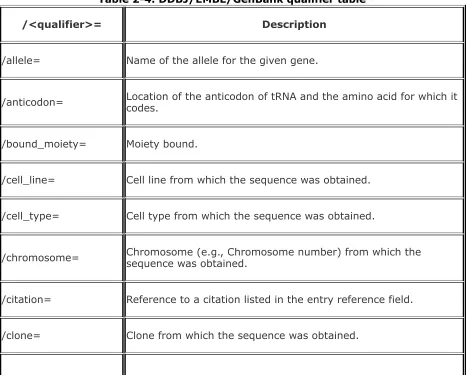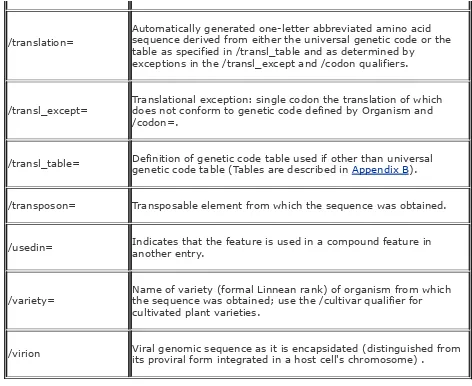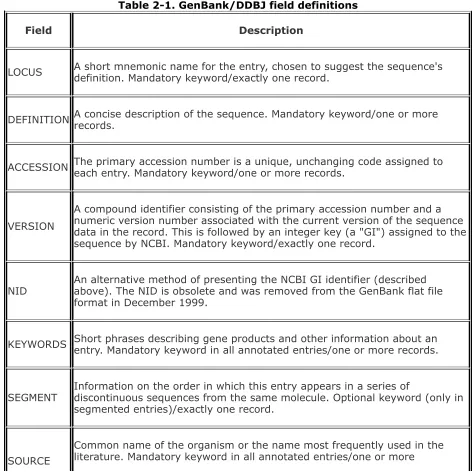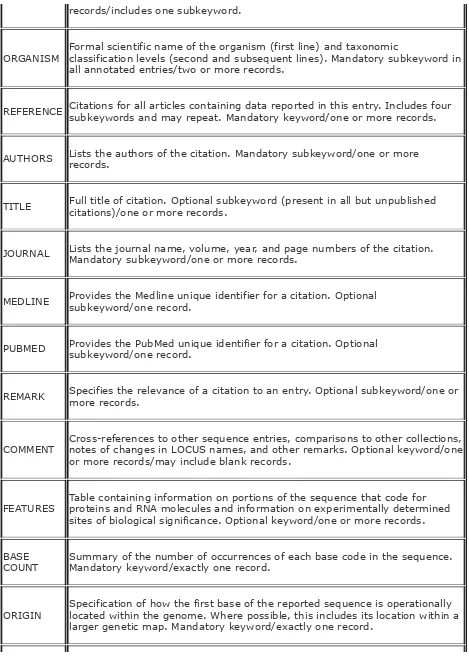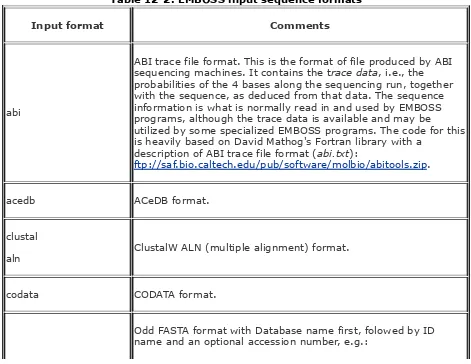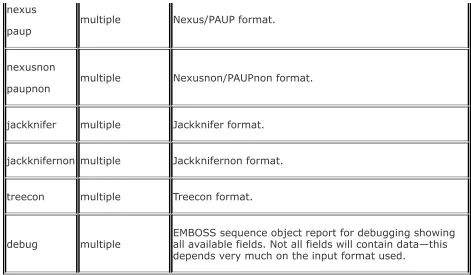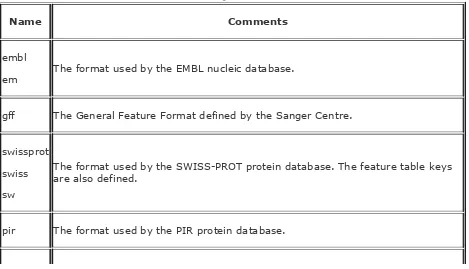[ Team LiB ]
[SYMBOL] [A] [B] [C] [D] [E] [F] [G] [H] [I] [J] [K] [L] [M] [N] [O] [P] [Q] [R] [S] [T] [U] [V] [W] [Y]
dan program (EMBOSS)
dasycladacean code databases
BLAST, indexing
CPGISLE, producing entry format reports DNA sequence, searching
EMBOSS, searching for sequences with specified IDs or numbers PRINTS
preprocessing for use with PSCAN PROSITE motif
REBASE
predicting cut sites in DNA sequences searching for restriction enzymes sequences, table listing ways to access
dbiblast program (EMBOSS)
dbifasta program (EMBOSS)
dbiflat program (EMBOSS)
dbigcg program (EMBOSS)
DDBJ (DNA Data Bank of Japan)
feature table [See DDBJ/EMBL/GenBank feature key table] flat files
example field definitions
locations [See DDBJ/EMBL/GenBank location examples table]
DDBJ/EMBL/GenBank feature table
DDBJ/EMBL/GenBank location examples table
DDBJ/EMBL/GenBank qualifier table
degapseq program (EMBOSS)
description lines, FASTA
descseq program (EMBOSS)
dichet program (EMBOSS)
diffseq program (EMBOSS)
digest program (EMBOSS)
dinucleotide CG, scanning for
dinucleotides, determining number of in files
distmat program (EMBOSS)
DNA constructs
linear maps of, drawing
DNA Data Bank of Japan [See DDBJ]
DNA double helixes, predicting bending of
DNA sequence databases, searching DNA sequences
displaying
predicting cut sites in predicting twisting of
domainer program (EMBOSS)
domains coordinate files, writing from protein coordinate files
dotmatcher program (EMBOSS)
dotpath program (EMBOSS)
dottup program (EMBOSS)
dreg program (EMBOSS)
[ Team LiB ]
[SYMBOL] [A] [B] [C] [D] [E] [F] [G] [H] [I] [J] [K] [L] [M] [N] [O] [P] [Q] [R] [S] [T] [U] [V] [W] [Y]
> (greater than sign), FASTA
: (colon), EMBOSS USA syntax
| (vertical bar), Readseq formats
[ Team LiB ]
[SYMBOL] [A] [B] [C] [D] [E] [F] [G] [H] [I] [J] [K] [L] [M] [N] [O] [P] [Q] [R] [S] [T] [U] [V] [W] [Y]
AAINDEX database
aaindexextract program (EMBOSS)
ABI sequence trace files
abiview program (EMBOSS)
alignment formats, EMBOSS
alignwrap program (EMBOSS)
alternative flatworm mitochondrial code
alternative yeast nuclear code amino acids
charges to
database of properties of properties summary amino-acid modifications SWISS-PROT feature table frequently used modifications lipid moiety attached groups
antigenic program (EMBOSS)
antisense, outputting
application groups, EMBOSS
ascidian mitochondrial code
ASCII files, removing carriage returns from
[ Team LiB ]
[SYMBOL] [A] [B] [C] [D] [E] [F] [G] [H] [I] [J] [K] [L] [M] [N] [O] [P] [Q] [R] [S] [T] [U] [V] [W] [Y]
backtranseq program (EMBOSS)
bacterial code
banana program (EMBOSS)
bases, searching sequences for
Basic Local Alignment Search Tool [See BLAST]
BioJava
BioPerl
biosed utility (EMBOSS)
bl2seq program (BLAST)
BLAST (Basic Local Alignment Search Tool) command-line options
databases, indexing programs
associated sequence types and server
support for Readseq
BLAST-Like Alignment Tool [See BLAT]
blastall program
blastpgp program (BLAST)
BLAT (BLAST-Like Alignment Tool)
blepharisma nuclear code
btwisted program (EMBOSS)
[ Team LiB ]
[SYMBOL] [A] [B] [C] [D] [E] [F] [G] [H] [I] [J] [K] [L] [M] [N] [O] [P] [Q] [R] [S] [T] [U] [V] [W] [Y]
cai program (EMBOSS)
carriage returns, removing from ASCII files
cDNA sequences, producing from aligned protein sequences
CGI web server, Readseq and
change indicators, SWISS-PROT feature table
chaos program (EMBOSS)
charge program (EMBOSS)
checktrans program (EMBOSS)
chips program (EMBOSS)
chlorophycean mitochondrial code
ciliate code
cirdna program (EMBOSS)
ClustalW
command-line options emma program as interface to
codcmp program (EMBOSS)
code, genetic
alternative flatworm mitochondrial alternative yeast nuclear
ascidian mitochondrial bacterial blepharisma nuclear chlorophycean mitochondrial ciliate coelenterate mitochondrial dasycladacean echinoderm euplotid nuclear flatworm mitochondrial hexamita nuclear invertebrate mitochondrial mold mycoplasma plant plastid protozoan
scenedesmus obliquus mitochondrial spiroplasma
standard
thraustochytrium mitochondrial trematode mitochondrial yeast mitochondrial
coderet program (EMBOSS) codes
coding sequences, calculating codon frequency table from nucleotide
Codon Adaptation Index, calculating
codon frequency tables
calculating from coding frequency
codon usage table files
coelenterate mitochondrial code
coiled-coil structures, calculating probability of
colon (:), EMBOSS USA syntax
command-line options BLAST BLAT ClustalW MEME Readseq comments, FASTA
compseq program (EMBOSS)
cons program (EMBOSS)
consensus sequence, calculating from multiple sequence alignment
contacts program (EMBOSS) coordinate files
writing protein-heterogen contact data files from
CpG regions, identifying
CPGISLE database, producing entry format reports
cpgplot program (EMBOSS)
cpgreport program (EMBOSS)
crystalball program
Ctrl-A characters, NCBI nonredundant database syntax
cusp program (EMBOSS)
cut sites, predicting in DNA sequences
CUTG, extracting data from
cutgextract program (EMBOSS)
cutseq program (EMBOSS)
[ Team LiB ]
[SYMBOL] [A] [B] [C] [D] [E] [F] [G] [H] [I] [J] [K] [L] [M] [N] [O] [P] [Q] [R] [S] [T] [U] [V] [W] [Y]
EBI (European Bioinformatics Institute)
echinoderm code
einverted program (EMBOSS)
EMBL (European Molecular Biology Laboratory) CD-ROM format index files
building from BLAST database building from FASTA flat file database building from flat file database
feature table [See DDBJ/EMBL/GenBank feature table] flat files
example field definitions format files
building from indexing GCG-format database converting SCOP classification files to writing SCOP classiciation to
format SCOP files, converting to nonredundant files
locations [See DDBJ/EMBL/GenBank location examples table] qualifier table [See DDBJ/EMBL/GenBank qualifier table]
EMBOSS (European Molecular Biology Open Software Suite) alignment formats
application groups
data files, determining directories that can hold databases [See EMBOSS databases]
feature formats
help documentation for, displaying programs
finding by keywords in documentation listing programs that share functionality with table of
report formats sequence formats input
output
Uniform Sequence Address (USA)
EMBOSS databases, searching for sequences with specified IDs or numbers
embossdata utility (EMBOSS)
embossversion program (EMBOSS)
emma program (EMBOSS)
emowse program (EMBOSS)
entret program (EMBOSS)
enzymatic data files, plotting
eprimer3 program (EMBOSS)
equicktandem program (EMBOSS)
EST sequences, trimming poly-A tails off
est2genome program (EMBOSS)
etandem program (EMBOSS)
euplotid nuclear code
European Bioinformatics Institute [See EBI]
European Molecular Biology Laboratory [See EMBL]
European Molecular Biology Open Software Suite [See EMBOSS]
extractfeat utility (EMBOSS)
extractseq program (EMBOSS)
[ Team LiB ]
[SYMBOL] [A] [B] [C] [D] [E] [F] [G] [H] [I] [J] [K] [L] [M] [N] [O] [P] [Q] [R] [S] [T] [U] [V] [W] [Y]
FASTA
flat file database, indexing open source tools and
feature formats, EMBOSS feature tables
DDBJ/EMBL/GenBank
extracting CDS/mRNA/translations from SWISS-PROT
writing representation of to standard output
features locations masking qualifiers
tables of [See feature tables] field definitions
DDBJ flat files EMBL flat files GenBank flat files Pfam flat files PROSITE flat files SWISS-PROT flat files files
ABI sequence trace
ASCII, removing carriage returns from codon usage table
coordinate
writing protein-heterogen contact data files from dinucleotides, counting number of
domains coordinate files, writing from protein coordinate files EMBL CD-ROM format index
building from BLAST database building from FASTA flat file database building from flat file database building from GCG-format database
EMBL-like format, writing SCOP classification to EMBOSS data, determining directories that can hold enzymatic data of, plottng
FASTA
sequence entries in
zzz [See also FASTA][See also FASTA] flat [See flat files]
hexanucleotides, counting number of inter-chain residue-residue contact data writing
intra-chain residue-residue contact data mass spectrometry result
PDB, parsing
profile matrix, creating from nucleic acid sequences protein coordinate
writing domains coordinate files from writing from PDB files
SCOP classification
converting/writing to EMBL-like format files removing low-resolution domains from removing redundant domains from
SWISS-PROT:PDB-equivalence, converting to EMBL-like format trinucleotides, counting number of
typing sequences into
findkm program (EMBOSS)
flat file databases, indexing
flat files
PROSITE example SWISS-PROT example
flatworm mitochondrial code
formatdb program
formatdb program (BLAST)
freak program (EMBOSS)
frequency tables, codon
funky program (EMBOSS)
fuzznuc program (EMBOSS)
fuzzpro program (EMBOSS)
fuzztran program (EMBOSS)
[ Team LiB ]
[SYMBOL] [A] [B] [C] [D] [E] [F] [G] [H] [I] [J] [K] [L] [M] [N] [O] [P] [Q] [R] [S] [T] [U] [V] [W] [Y]
G+C percentage of nucleic acid sequences, calculating 2nd
gaps in aligned sequences, removing
Garnier Osguthorpe Robson algorithm (GOR I)
garnier program (EMBOSS)
GC content, plotting over sequences
GCG-format databases
geecee program (EMBOSS) GenBank
flat files example field definitions
locations [See DDBJ/EMBL/GenBank location examples table]
genetic code
alternative flatworm mitochondrial code alternative yeast nuclear code
ascidian mitochondrial code bacterial code
blepharisma nuclear code chlorophycean mitochondrial code ciliate code
dasycladacean code echinoderm code euplotid nuclear code flatworm mitochondrial code hexamita nuclear code
invertebrate mitochondrial code plant plastid code
scenedesmus obliquus mitochondrial code standard
thraustochytrium mitochondrial code trematode mitochondrial code yeast mitochondrial code
getorf program (EMBOSS)
GOR I (Garnier Osguthorpe Robson algorithm)
greater than sign (>), FASTA
GRIBSKOV profiles, finding matches with sequences
[ Team LiB ]
[SYMBOL] [A] [B] [C] [D] [E] [F] [G] [H] [I] [J] [K] [L] [M] [N] [O] [P] [Q] [R] [S] [T] [U] [V] [W] [Y]
helixturnhelix program (EMBOSS)
HENIKOFF profiles, finding matches with sequences heterogen groups
converting raw dictionary to EMBL-like file format parse dictionary of
hexamita nuclear code
hexanucleotides, determining number of in files
hidden Markov model (HMM)
HMM (hidden Markov model)
generating for directory alignments
HMMER programs
hmmgen program (EMBOSS)
hmoment program (EMBOSS)
hteparse program (EMBOSS)
hydrophobic moment
[ Team LiB ]
[SYMBOL] [A] [B] [C] [D] [E] [F] [G] [H] [I] [J] [K] [L] [M] [N] [O] [P] [Q] [R] [S] [T] [U] [V] [W] [Y]
iep program (EMBOSS)
infoalign utility (EMBOSS)
infoseq utility (EMBOSS)
inter-chain residue-residue contact data files, writing
interface program (EMBOSS)
International Nucleotide Sequence Database Collaboration
intra-chain residue-residue contact data files, writing
invertebrate mitochondrial code
inverted repeats in nucleotide sequences
isochore program (EMBOSS)
isoelectric point
[ Team LiB ]
[SYMBOL] [A] [B] [C] [D] [E] [F] [G] [H] [I] [J] [K] [L] [M] [N] [O] [P] [Q] [R] [S] [T] [U] [V] [W] [Y]
Java API for EMBOSS
Jemboss
[ Team LiB ]
[SYMBOL] [A] [B] [C] [D] [E] [F] [G] [H] [I] [J] [K] [L] [M] [N] [O] [P] [Q] [R] [S] [T] [U] [V] [W] [Y]
Kyte & Doolittle hydropathy plot of protein sequences, displaying
[ Team LiB ]
[SYMBOL] [A] [B] [C] [D] [E] [F] [G] [H] [I] [J] [K] [L] [M] [N] [O] [P] [Q] [R] [S] [T] [U] [V] [W] [Y]
lindna program (EMBOSS)
listor program (EMBOSS)
locations
low-resolution domains, removing from SCOP classification files
[ Team LiB ]
[SYMBOL] [A] [B] [C] [D] [E] [F] [G] [H] [I] [J] [K] [L] [M] [N] [O] [P] [Q] [R] [S] [T] [U] [V] [W] [Y]
MAR/SAR sites, finding in nucleic acid sequences
Markow models
marscan program (EMBOSS)
maskfeat program (EMBOSS)
maskseq program (EMBOSS)
mass spectrometry
matching data in protein databases
MAST (Motif Alignment and Search Tool) command-line options
examples
matcher program (EMBOSS)
megablast program (BLAST)
megamerger program (EMBOSS)
melting temperature of nucleic acid sequences, calculating
MEME (Multiple EM for Motif Elicitation) command-line options
examples
MEME/MAST
merger program (EMBOSS)
model organisms
mold code
molecular weights, finding in mass spectrometry result files
msbar program (EMBOSS)
Multiple EM for Motif Elicitation [See MEME] multiple sequence alignment
calculating
consensus sequence from evolutionary distances between EMBOSS formats
mwcontam program (EMBOSS)
mwfilter program (EMBOSS)
mycoplasma code
[ Team LiB ]
[SYMBOL] [A] [B] [C] [D] [E] [F] [G] [H] [I] [J] [K] [L] [M] [N] [O] [P] [Q] [R] [S] [T] [U] [V] [W] [Y]
National Center for Biotechnology Information [See NCBI]
National Institutes of Health (NIH)
National Library of Medicine (NLM)
NCBI (National Center for Biotechnology Information) BLAST server, syntax for
nonredundant database syntax
needle program (EMBOSS)
Needleman-Wunsch global alignment algorithm
newcpgreport program (EMBOSS)
newcpgseek program (EMBOSS)
newseq program (EMBOSS)
NIH (National Institutes of Health)
NLM (National Library of Medicine)
noreturn program (EMBOSS)
notseq program (EMBOSS)
nrscope program (EMBOSS)
nthseq program (EMBOSS)
nucleic acid sequences calculating G+C of 2nd
calculating melting temperature of creating profile matrix file from displaying in publication format 2nd
displaying protein translation in publication format finding MAR/SAR sites in
finding recognition sites in matching to regular expressions merging
scanning for silent mutation restriction enzyme sites searching with PROSITE-style protein patterns translating to peptide sequences
nucleotide codes nucleotide sequences inverted repeats in 2nd scanning for dinucleotide CG scanning for restriction sites
searching with PROSITE-style patterns
[ Team LiB ]
[SYMBOL] [A] [B] [C] [D] [E] [F] [G] [H] [I] [J] [K] [L] [M] [N] [O] [P] [Q] [R] [S] [T] [U] [V] [W] [Y]
octanol program (EMBOSS)
open reading frames [See ORFs]
open source tools for parsing/writing FASTA files ORFs (open reading frames)
outputting sequences of plotting
[ Team LiB ]
[SYMBOL] [A] [B] [C] [D] [E] [F] [G] [H] [I] [J] [K] [L] [M] [N] [O] [P] [Q] [R] [S] [T] [U] [V] [W] [Y]
pairwise sequence alignment formats, EMBOSS
palindrome program (EMBOSS)
parse dictionary of heterogen groups
pasteseq program (EMBOSS)
patmatdb program (EMBOSS)
patmatmotifs program (EMBOSS)
Pattern-Hit Initiated BLAST (PHI-BLASTÑsee PHI-BLAST program)
patterns
PCR reactions, selecting primers for
PDB files, parsing
pdbpars program (EMBOSS)
pdbtosp program (EMBOSS)
pepcoil program (EMBOSS)
pepinfo program (EMBOSS)
pepnet program (EMBOSS)
pepstats program (EMBOSS) peptide sequences
determining where proteolytic enzymes might cut displaying in helical representation
pepwheel program (EMBOSS)
pepwindow program (EMBOSS)
pepwindowall program (EMBOSS)
Pfam flat files example field definitions
PHI-BLAST (Pattern-Hit Initiated BLASTÑsee PHI-BLAST program)
PHI-BLAST program (BLAST) PROSITE conventions
phylogenetic analysis
plant plastid code
plotcon program (EMBOSS)
plotorf program (EMBOSS)
polydot program (EMBOSS)
Position-Specific Iterated BLAST (PSI-BLASTÑsee PSI-BLAST program)
preg program (EMBOSS)
pressdb program
prettyplot program (EMBOSS)
prettyseq program (EMBOSS)
primer pairs, searching against sequences
primer3 program, eprimer3 program as interface to
primersearch program (EMBOSS)
PRINTS databases
preprocessing for use with PSCAN program
printsextract program (EMBOSS)
profgen program (EMBOSS)
profile matrix files, creating from nucleic acid sequences
profiles
profit program (EMBOSS) programs
BLAST EMBOSS table of HMMER
prophecy program (EMBOSS)
prophet program (EMBOSS)
prosextract program (EMBOSS)
PROSITE flat files example field definitions PHI-BLAST program and
PROSITE motif databases protein coordinate files
writing from PDB files
protein databases, matching mass spectrometry data in
protein functions, determining
protein motifs
comparing to PROSITE motif database comparing to protein sequences
finding helix-turn-helix nucleic acid binding in identifying quickly
protein sequences antigenic regions
calculating multiple alginment of charges to amino acids
creating profile matrix file from
determining nucleic acid sequence source displaying
publication format
displaying graph of Kyte & Doolittle hydropathy plot of displaying in publication format
metrics about
producing cDNA sequences from reports about
searching for match of regular expression to searching with PROSITE-style patterns stops in
protein signal cleavage sites, reporting
protein-heterogen contact data files, writing from coordinate files proteins
calculating isoelectric point of displaying residues of newly discovered
predicting transmembrane segments in protein coding regions, analyzing protein hydropathy, displaying scanning with PRINTS
proteolytic enzymes
protozoan code
PSCAN program
pscan program (EMBOSS)
PSI-BLAST (Position-Specific Iterated BLASTÑsee PSI-BLAST program)
PSI-BLAST program (BLAST)
psiblast program (EMBOSS)
[ Team LiB ]
[SYMBOL] [A] [B] [C] [D] [E] [F] [G] [H] [I] [J] [K] [L] [M] [N] [O] [P] [Q] [R] [S] [T] [U] [V] [W] [Y]
qualifiers
DDBJ/EMBL/GenBank qualifier table
[ Team LiB ]
[SYMBOL] [A] [B] [C] [D] [E] [F] [G] [H] [I] [J] [K] [L] [M] [N] [O] [P] [Q] [R] [S] [T] [U] [V] [W] [Y]
Readseq
command-line options
feature table extraction options formats supported
REBASE database
finding recognition sites in nucleic acid sequences searching for specified restriction enzymes using to predict cut sites in DNA sequences
rebaseextract program (EMBOSS)
recoder program (EMBOSS)
recognition sites, finding in nucleic acid sequences
redata program (EMBOSS)
regions, SWISS-PROT feature table regular expressions
matching to nucleic acid sequences matching to protein sequences
remap program (EMBOSS)
report formats, EMBOSS
residues, searching sequences for
resources for further information amino acids BLAST web sites BLAT web sites ClustalW web sites DDBJ web sites EMBL web sites EMBOSS web sites GenBank web sites genetic code HMM HMMER web sites Jemboss MEME/MAST NCBI nucleic acids Pfam web sites PROSITE web sites Readseq SWISS-PROT web sites
restrict program (EMBOSS)
restriction enzymes, searching REBASE database for
reverse sense, outputting
revseq program (EMBOSS)
[ Team LiB ]
[SYMBOL] [A] [B] [C] [D] [E] [F] [G] [H] [I] [J] [K] [L] [M] [N] [O] [P] [Q] [R] [S] [T] [U] [V] [W] [Y]
sample sequence formats, FASTA entry
scenedesmus obliquus mitochondrial code
SCOP classification files
scopalign program (EMBOSS)
scope program (EMBOSS)
scopnr program (EMBOSS)
scopparse program (EMBOSS)
scoprep program (EMBOSS)
scopreso program (EMBOSS)
scopseqs program (EMBOSS) secondary structures
predicting 2nd
SWISS-PROT feature table
seealso program (EMBOSS)
seed alignments
seqalign program (EMBOSS)
seqmatchall program (EMBOSS)
seqret program (EMBOSS)
seqretsplit program (EMBOSS)
seqsearch program (EMBOSS)
seqsort program (EMBOSS) sequence analysis
subfields of
tools for performing, list of
sequence annotation
sequence data lines, FASTA
sequence databases MAST and
table listing ways to access sequence formats
EMBOSS input output
FASTA [See FASTA] sequences
aligned
alignment formats
plotting quality of conservation of removing gaps from
using Smith-Waterman algorithm
cDNA, producing from aligned protein sequences comparing 2nd
all-against-all pairwise
matching words of specified length nonoverlapping wordmatch plot display comparing/matching with BLAST
concatenating CpG areas in
creating game representation plots for descriptive text of, searching
displaying DNA
predicting cut sites in predicting twisting of editing 2nd
EST, trimming poly-A tails off excluding
extracting pairs of
finding matches with GRIBSKOV/HENIKOFF profiles finding optimum alignment of
masking features of matching
merging
multiple alignment
calculating consensus sequence from calculating evolutionary distances between mutating
names of, adding to list file nucleic acid
calculating fraction of G+C bases of calculating melting temperature of calculating multiple alignment of calculating percent G+C of creating profile matrix file from displaying in publication format 2nd
displaying protein translation in publication format finding MAR/SAR sites in
finding recognition sites in matching to regular expressions merging
scanning for silent mutation restriction enzyme sites searching with PROSITE-style protein patterns translating to peptide sequences
nucleotide
inverted repeats in 2nd scanning for dinucleotide CG scanning for restriction sites
searching with PROSITE-style patterns of ORFs
outputting reverse complement of peptide
determining where proteolytic enzymes might cut displaying in helical representation
translating to nucleic acid sequences plotting GC content over
protein [See also protein sequences][See also protein sequences] searching for match of regular expression to
randomly shuffling order of reading/writing
in individual files regions of
masking off removing
reporting differences between retrieving from SWISS-PROT scanning for tandem repeats searching EMBOSS databases for searching for bases/residues searching primer pairs against set of, comparing
skipping
spliced nucleotide, aligning to unspliced genomic DNA sequences stripping vector sequences from
tandem repeats in tidying up ends of
TRANSFAC, matching against input sequences typing into files
seqwords program (EMBOSS)
setdb program
showalign program (EMBOSS)
showdb program (EMBOSS)
showfeat program (EMBOSS)
showorf program (EMBOSS)
showseq program (EMBOSS)
shuffleseq program (EMBOSS)
SIB (Swiss Institute of Bioinformatics)
side chains of amino acids
sigcleave program (EMBOSS)
sigscan program (EMBOSS)
silent mutation restriction enzyme sites, scanning nucleic acid sequences for
silent program (EMBOSS)
skipseq program (EMBOSS)
Smith-Waterman algorithm, calculating local alignment
spiroplasma code
spliced nucleotide sequences, aligning to unspliced genomic DNA sequences
standard code
stretcher program (EMBOSS)
stssearch program (EMBOSS)
supermatcher program (EMBOSS)
Swiss Institute of Bioinformatics (SIB)
SWISS-PROT
feature table [See SWISS-PROT feature table] flat files
example field definitions retrieving sequences from
SWISS-PROT feature table amino-acid modifications lipid moiety attached groups most frequently used change indicators regions
secondary structure
SWISS-PROT:PDB-equivalence files, converting to EMBL-like format
swissparse program (EMBOSS)
syco program (EMBOSS)
[ Team LiB ]
[SYMBOL] [A] [B] [C] [D] [E] [F] [G] [H] [I] [J] [K] [L] [M] [N] [O] [P] [Q] [R] [S] [T] [U] [V] [W] [Y]
tandem repeats, scanning sequences for
temperature, melting, of nucleic acid sequences, calculating
textsearch utility (EMBOSS)
tfextract program (EMBOSS)
tfm program (EMBOSS)
tfscan program (EMBOSS)
third position variability, plotting as indicator of potential coding region
thraustochytrium mitochondrial code
thresholded plot display
tmap program (EMBOSS) tools
list of
open source, FASTA files and
tranalign program (EMBOSS)
transeq program (EMBOSS) TRANSFAC
extracting data from
sequences, matching against input sequences
transmembrane segments, predicting in proteins
trematode mitochondrial code
TrEMBL [See also SWISS-PROT]2nd
trimest program (EMBOSS)
trimseq program (EMBOSS)
trinucleotides, determining number of in files
[ Team LiB ]
[SYMBOL] [A] [B] [C] [D] [E] [F] [G] [H] [I] [J] [K] [L] [M] [N] [O] [P] [Q] [R] [S] [T] [U] [V] [W] [Y]
Uniform Sequence Address (USA)
union program (EMBOSS)
unspliced DNA sequences, aligning to spliced nucleotide sequences
USA (Uniform Sequence Address)
[ Team LiB ]
[SYMBOL] [A] [B] [C] [D] [E] [F] [G] [H] [I] [J] [K] [L] [M] [N] [O] [P] [Q] [R] [S] [T] [U] [V] [W] [Y]
vector sequences, stripping from other sequences
vectorstrip program (EMBOSS)
vertical bar (|), Readseq formats
[ Team LiB ]
[SYMBOL] [A] [B] [C] [D] [E] [F] [G] [H] [I] [J] [K] [L] [M] [N] [O] [P] [Q] [R] [S] [T] [U] [V] [W] [Y]
water program (EMBOSS)
whichdb program (EMBOSS)
white space, FASTA
wobble program (EMBOSS)
wordcount program (EMBOSS)
wordmatch program (EMBOSS)
wossname program (EMBOSS)
[ Team LiB ]
[SYMBOL] [A] [B] [C] [D] [E] [F] [G] [H] [I] [J] [K] [L] [M] [N] [O] [P] [Q] [R] [S] [T] [U] [V] [W] [Y]
yank program (EMBOSS)
yeast mitochondrial code
dan
dan
calculates the melting temperature (Tm) and the percent
G+C of a nucleic acid sequence (optionally plotting them).
Here is a sample session with
dan
:
% dan
Input sequence: embl:paamir
Enter window size [20]:
Enter Shift Increment [1]:
Enter DNA concentration (nM) [50.]:
Enter salt concentration (mM) [50.]:
Output file [paamir.dan]:
An example of producing a plot of Tm:
% dan -plot
Input sequence(s): embl:paamir
Enter window size [20]:
Enter Shift Increment [1]:
Enter DNA concentration (nM) [50.]:
Enter salt concentration (mM) [50.]:
Enter minimum temperature [55.]:
Graph type [x11]:
Mandatory qualifiers (bold if not always prompted):
[-sequence] (seqall)
Sequence database USA.
The values of melting point and other thermodynamic
properties of the sequence are determined by taking a short
length of sequence known as a window and determining the
properties of the sequence in that window. The window is
incrementally moved along the sequence, and the
properties are calculated at each new position.
-shiftincrement (integer)
This is the amount the window is moved at each increment
in order to find the melting point and other properties along
the sequence.
-dnaconc (float)
Enter DNA concentration (nM).
-saltconc (float)
Enter salt concentration (mM).
-formamide (float)
This specifies the percent formamide to be used in
calculations (ignored unless
-product
is used).
-mismatch (float)
This specifies the percent mismatch to be used in
calculations (ignored unless
-product
is used).
-prodlen (integer)
This specifies the product length to be used in calculations
(ignored unless
-product
is used).
-mintemp (float)
the plot.
-graph (xygraph)
Graph type.
-outfile (report)
If a plot is not being produced, data (on the melting point
etc., in each window along the sequence) is output to this
file.
Optional qualifiers (bold if not always prompted):
-temperature (float)
If
-thermo
has been specified, this specifies the
temperature at which to calculate the DeltaG, DeltaH and
DeltaS values.
Advanced qualifiers:
-rna (boolean)
This specifies that the sequence is an RNA sequence, not a
DNA sequence.
-product (boolean)
This prompts for percent formamide, percent of mismatches
allowed, and product length.
-thermo (boolean)
Output the DeltaG, DeltaH, and DeltaS values of the
sequence windows to the output data file.
B.6 Ciliate, Dasycladacean, and Hexamita Nuclear Code
TTT F Phe
TCT S Ser
TAT Y Tyr
TGT C Cys
TTC F Phe
TCC S Ser
TAC Y Tyr
TGC C Cys
TTA L Leu
TCA S Ser
TAA Q Gln
TGA * Ter
TTG L Leu
TCG S Ser
TAG Q Gln
TGG W Trp
CTT L Leu
CCT P Pro
CAT H His
CGT R Arg
CTC L Leu
CCC P Pro
CAC H His
CGC R Arg
CTA L Leu
CCA P Pro
CAA Q Gln
CGA R Arg
CTG L Leu
CCG P Pro
CAG Q Gln
CGG R Arg
ATT I Ile
ACT T Thr
AAT N Asn
AGT S Ser
ATC I Ile
ACC T Thr
AAC N Asn
AGC S Ser
ATA I Ile
ACA T Thr
AAA K Lys
AGA R Arg
ATG M Met i
ACG T Thr
AAG K Lys
AGG R Arg
GTC V Val
GCC A Ala
GAC D Asp
GGC G Gly
GTA V Val
GCA A Ala
GAA E Glu
GGA G Gly
GTG V Val
GCG A Ala
GAG E Glu
GGG G Gly
The following table contains the differences in the Ciliate,
Dasycladacean, and Hexamita Nuclear Code from the Standard
Code.
Codon Ciliate, Dasycladacean, and Hexamita Nuclear Standard
UAA Q Gln * Ter
dbiblast
dbiblast
indexes a BLAST database created by the NCBI
indexing programs (
formatdb
,
pressdb
, or
setdb
) and builds
EMBL CD-ROM format index files.
Here is a sample session with
dbiblast
, using a BLAST2 protein
database:
% dbiblast
NCBI : NCBI with | characters
GCG : GCG format dbname:entryname
SIMPLE : ID and accession
ID : entryname
UNKNOWN : unknown
Entry format [unknown]: gcg
Database name: swnew
Database directory [.]: /nfs/disk42/pmr/emboss/test/blastp2/
database base filename [swnew]:
Release number [0.0]:
Index date [00/00/00]: 04/02/00
N : nucleic
P : protein
? : unknown
Sequence type [unknown]: p
1 : wublast and setdb/pressdb
2 : formatdb
0 : unknown
Blast index version [unknown]: 2
Mandatory qualifiers:
Database name.
-directory (string)
Database directory.
-filenames (string)
Wildcard database filename.
-release (string)
Release number.
-date (string)
Index date.
-seqtype (menu)
Sequence type.
-blastversion (menu)
BLAST index version.
Advanced qualifiers:
-fields (menu)
Index fields.
-exclude (string)
Wildcard filename(s) to exclude.
-indexdirectory (string)
-sortoptions (string)
Sort options, typically
-T
. to use current directory for work
files, or
-k 1,1
to force GNU sort to use the first field.
-maxindex (integer)
Maximum index length.
-[no]systemsort (boolean)
Use system sort utility.
-[no]cleanup (boolean)
Clean up temporary files.
-sourcefile (boolean)
newcpgreport
newcpgreport
is used in the production of the CpG Island
database CPGISLE. It produces CPGISLE database entry format
reports for a potential CpG island. See the FTP site:
ftp://ftp.ebi.ac.uk/pub/databases/cpgisle/
for the finished
database.
Here is a sample session with
newcpgreport
:
% newcpgreport
Input sequence: embl:rnu68037
Window size [100]:
Shift increment [1]:
Minimum Length [200]:
Minimum observed/expected [0.6]:
Minimum percentage [50.]:
Output file [rnu68037.newcpgreport]:
Mandatory qualifiers:
[-sequence] (seqall)
Sequence database USA.
-window (integer)
Window size.
-shift (integer)
Shift increment.
-minlen (integer)
-minoe (float)
Minimum observed or expected.
-minpc (float)
Minimum percentage.
[-outfile] (outfile)
stssearch
stssearch
searches a DNA sequence database with a set of STS
primers and reports expected matches and possible
mismatches.
Here is a sample session with
stssearch
:
% stssearch
Input sequence(s): embl:eclac*
Primer file: lac.primers
Mandatory qualifiers:
[-sequences] (seqall)
Sequence database USA.
[-primers] (infile)
Primer file.
[-out] (outfile)
whichdb
whichdb
searches all available EMBOSS databases for
sequences with a specified ID name or accession number.
Here is a sample session with
whichdb
:
% whichdb
Search all databases for an entry
ID or Accession number: hsfau
Output file [outfile.whichdb]:
Mandatory qualifiers (bold if not always prompted):
[-entry] (string)
ID or accession number.
-outfile (outfile)
Output filename.
Advanced qualifiers:
-get (boolean)
pscan
pscan
scans proteins using
PRINTS
. The home web page of the
PRINTS
database is
http://www.bioinf.man.ac.uk/dbbrowser/PRINTS/
.
Here is a sample session with
pscan
:
% pscan
Scans proteins using PRINTS
Input sequence(s): sw:OPSD_HUMAN
Minimum number of elements per fingerprint [2]:
Maximum number of elements per fingerprint [20]:
Output file [opsd_human.pscan]:
Mandatory qualifiers:
[-sequence] (seqall)
Sequence database USA.
-emin (integer)
Minimum number of elements per fingerprint.
-emax (integer)
Maximum number of elements per fingerprint.
[-outfile] (outfile)
printsextract
printsextract
preprocesses the
PRINTS
database for use with
the program
PSCAN
.
Here is a sample session with
printsextract
:
% printsextract
Full pathname of PRINTS.DAT: /data/prints/prints.dat
Mandatory qualifiers:
[-inf] (infile)
prosextract
prosextract
builds the
PROSITE
motif database for
patmatmotifs
to search.
Here is a sample session with
prosextract
:
% prosextract
Extracting ID, AC & PA lines from the Prosite motif Database.
Enter name of prosite directory: data/PROSITE
% more prosite.lines
ASN_GLYCOSYLATION PS00001
N-glycosylation
N-{P}-[ST]-{P}
^N[^P][ST][^P]
CAMP_PHOSPHO_SITE PS00004
cAMP-[RK](2)-x-[ST]
^[RK]{2}[^BJOUXZ][ST]
PKC_PHOSPHO_SITE PS00005
Protein
[ST]-x-[RK]
^[ST][^BJOUXZ][RK]
CK2_PHOSPHO_SITE PS00006
Casein
[ST]-x(2)-[DE]
etc...
The output files named after the
prosite
access numbers can
also be seen in the
prosite
directory. This files are automatically
created after
prosextract
is run.
Mandatory qualifiers:
[-infdat] (string)
restrict
restrict
uses the REBASE database of restriction enzymes to
predict cut sites in a DNA sequence.
Here is a sample session with
restrict
:
% restrict
Finds restriction enzyme cleavage sites
Input sequence(s): embl:hsfau
Minimum recognition site length [4]:
Comma separated enzyme list [all]:
Output file [hsfau.restrict]:
Mandatory qualifiers:
[-sequence] (seqall)
Sequence database USA.
-sitelen (integer)
Minimum recognition site length.
-enzymes (string)
The argument
all
reads all enzyme names from the
REBASE database. You can specify enzymes by giving their
names with commas between them, such as:
HincII,hinfI,ppiI,hindiii
. This command is not
case-sensitive. You may also use the data from file
containing enzyme names by prepending the name of the
file you want to use with an
@
character; for example,
concatenated together with a comma and treated as the list
of enzymes to search for. A file containing enzyme names
might look like this:
! my enzymes
HincII, ppiII
! other enzymes
hindiii
HinfI
PpiI
[-outfile] (report)
Output report filename.
Advanced qualifiers:
-min (integer)
Minimum cuts per restriction enzyme.
-max (integer)
Maximum cuts per restriction enzyme.
-single (boolean
Force single site only cuts.
-[no]blunt (boolean)
Allow blunt end cutters.
-[no]sticky (boolean)
Allow sticky end cutters.
Allow ambiguous matches.
-plasmid (boolean)
Allow circular DNA.
-[no]commercial (boolean)
Only enzymes with suppliers.
-datafile (string)
Alternative restriction enzyme data file.
-[no]limit (boolean)
Limits reports to one isoschizomer.
-preferred (boolean)
Report preferred isoschizomers.
-alphabetic (boolean)
Sort output alphabetically.
-fragments (boolean)
Show fragment lengths.
-name (boolean)
redata
redata
searches the REBASE database for information on a
specified restriction enzyme.
Here is a sample session with
redata
:
% redata
Search REBASE for enzyme name, references, suppliers etc.
Restriction enzyme name [BamHI]:
Output file [outfile.redata]:
Mandatory qualifiers:
[-enzyme] (string)
Enter the name of the restriction enzyme you want to
examine. The names often contain an "I". This is a capital
letter "i", not a numeric "1" or the letter "l". The names are
case-independent (
AaeI
is the same as
aaei
).
[-outfile] (outfile)
Output filename.
Advanced qualifiers:
-[no]isoschizomers (boolean)
Show other enzymes with this specificity (isoschizomers).
-[no]references (boolean)
Show references.
showdb
showdb
writes out a simple table displaying the names,
contents, and available ways to access the sequence databases.
Display information on the currently available databases:
% showdb
Write out the display to a file:
% showdb -outfile showdb.out
Display information on one explicit database:
% showdb -database swissprot
Display information on the databases formatted for inclusion in
HTML:
% showdb -html
Display protein databases only:
% showdb -nonucleic
Display the information with no headings:
% showdb -noheading
Display just a list of the available database names:
% showdb -noheading -notype -noid -noquery -noall -nocomment -auto
% showdb -only -type
Optional qualifiers:
-database (string)
Name of a single database to give information on.
-html (boolean)
Format output as an HTML table.
-[no]protein (boolean)
Display protein databases.
-[no]nucleic (boolean)
Display nucleic acid databases.
-release (boolean)
Display "release" column.
-outfile (outfile)
If you enter the name of a file here, this program writes the
database details into that file.
Advanced qualifiers:
-only (boolean)
-heading (boolean)
Display column headings.
-type (boolean)
Display "type" column.
-id (boolean)
Display "id" column.
-query (boolean)
Display "qry" column.
-all (boolean)
Display "all" column.
-comment (boolean)
dbifasta
dbifasta
indexes a FASTA format flat file database of one or
more files, and builds EMBL CD-ROM format index files.
Here is a sample session with
dbifasta
, using data in the
test/wormpep
directory of the distribution (normally indexed as
wormpep
):
% dbifasta
Index a fasta database
simple : >ID
idacc : >ID ACC
gcgid : >db:ID
gcgidacc : >db:ID ACC
ncbi : >blah|...[|ACC]|ID
ID line format [idacc]: idacc
Database name: wormpep
Database directory [.]: /data/worm/
Wildcard database filename [*.dat]: wormpep
Release number [0.0]: 1.0
Index date [00/00/00]: 04/02/00
Mandatory qualifiers:
-idformat (menu)
ID line format.
-directory (string)
Database directory.
Wildcard database filename.
[-dbname] (string)
Database name.
-release (string)
Release number.
-date (string)
Index date.
Advanced qualifiers:
-fields (menu)
Index fields.
-exclude (string)
Wildcard filename(s) to exclude.
-indexdirectory (string)
Index directory.
-maxindex (integer)
Maximum index length.
-sortoptions (string)
Sort options, typically
-T
. to use current directory for work
files, or
-k 1,1
to force GNU sort to use the first field.
Use system sort utility.
-[no]cleanup (boolean)
dbiflat
dbiflat
indexes a flat file database of one or more files and
builds EMBL CD-ROM format index files.
Here is a sample session with
dbiflat
, using the data in the
test/embl
directory of the distribution (normally indexed as
tembl
):
% dbiflat
EMBL : EMBL
SWISS : Swiss-Prot, SpTrEMBL, TrEMBLnew
GB : Genbank, DDBJ
Entry format [SWISS]: EMBL
Database name: tembl
Database directory [.]: /nfs/disk42/pmr/emboss/osf/emboss/test/embl/
Wildcard database filename [*.dat]:
Release number [0.0]: 1.0
Index date [00/00/00]: 04/02/00
Mandatory qualifiers:
-idformat (menu)
Entry format.
-directory (string)
Database directory.
-filenames (string)
Wildcard database filename.
Database name.
-release (string)
Release number.
-date (string)
Index date.
Advanced qualifiers:
-fields (menu)
Index fields.
-exclude (string)
Wildcard filename(s) to exclude.
-indexdirectory (string)
Index directory.
-maxindex (integer)
Maximum index length.
-sortoptions (string)
Sort options, typically
-T
. to use current directory for work
files, or -
k 1,1
to force GNU sort to use the first field.
-[no]systemsort (boolean)
Use system sort utility.
dbigcg
dbigcg
indexes a GCG-format database of one or more files and
builds EMBL CD-ROM format index files.
Here is a sample session with
dbigcg
:
% dbigcg
EMBL : EMBL
SWISS : Swiss-Prot, SpTrEMBL, TrEMBLnew
GB : Genbank, DDBJ
PIR : NBRF
Entry format [EMBL]:
Database name: tembl
Database directory [.]: /nfs/disk42/pmr/emboss/test/gcgembl/
Wildcard database filename [*.seq]:
Release number [0.0]:
Index date [00/00/00]: 04/02/00
Mandatory qualifiers:
-idformat (menu)
Entry format.
-directory (string)
Database directory.
-filenames (string)
Wildcard database filename.
Database name.
-release (string)
Release number.
-date (string)
Index date.
Advanced qualifiers:
-fields (menu)
Index fields.
-exclude (string)
Wildcard filename(s) to exclude.
-indexdirectory (string)
Index directory.
-maxindex (integer)
Maximum index length.
sortoptions (string)
Sort options, typically
-T
. to use current directory for work
files, or
-k 1,1
to force GNU sort to use the first field.
-[no]systemsort (boolean)
Use system sort utility.
Chapter 2. GenBank/EMBL/DDBJ
2.7 DDBJ/EMBL/GenBank Feature Table
In February 1986, GenBank and EMBL (joined by DDBJ in 1987)
started a collaborative effort to create a common feature table
format. The overall objective of the feature table was to supply
an in-depth vocabulary for describing nucleotide (and protein)
features. We're using Version 4 of the feature table.
2.7.1 Features
A feature is a single word or abbreviation indicating a functional
role or region associated with a sequence. A list of
DDBJ/EMBL/GenBank features is presented in
Table 2-3
. In the
Definition column of the table, the appropriate qualifiers for
each feature are in brackets. Mandatory qualifiers are
highlighted in bold.
Table 2-3. DDBJ/EMBL/GenBank feature key table
Feature Key Definition
attenuator
1) region of DNA at which regulation of termination of transcription occurs, which controls the expression of some bacterial operons.
2) sequence segment located between the promoter and the first structural gene that causes partial termination of transcription.
[citation, db_xref, evidence, gene, label, map, note, phenotype, usedin]
C_region
Constant region of immunoglobulin light and heavy chains, and T-cell receptor alpha, beta, and gamma chains; includes one or more exons depending on the particular chain.
[citation, db_xref, evidence, gene, label, map, note, product, pseudo, standard_name, usedin]
CAAT_signal
CAAT box; part of a conserved sequence located about 75 bp up-stream of the start point of eukaryotic transcription units which may be involved in RNA polymerase binding; consensus=GG (C or T) CAATCT.
CDS
Coding sequence; sequence of nucleotides that corresponds with the sequence of amino acids in a protein (location includes stop codon); feature includes amino acid conceptual translation.
[allele, citation, codon, codon_start, db_xref, EC_number, evidence, exception, function, gene, label, map, note, number, product, protein_id, pseudo, standard_name, translation, transl_except, transl_table, usedin]
conflict
Independent determinations of the "same" sequence differ at this site or region.
[citation, db_xref, evidence, label, map, note, gene, replace, usedin]
D-loop
Displacement loop; a region within mitochondrial DNA in which a short stretch of RNA is paired with one strand of DNA, displacing the original partner DNA strand in this region. Also used to describe the displacement of a region of one strand of duplex DNA by a single stranded invader in the reaction catalyzed by RecA protein.
[citation, db_xref, evidence, gene, label, map, note, usedin]
D_segment
Diversity segment of immunoglobulin heavy chain, and T-cell receptor beta chain
[citation, db_xref, evidence, gene, label, map, note, product, pseudo, standard_name, usedin]
enhancer
A cis-acting sequence that increases the utilization of (some) eukaryotic promoters, and can function in either orientation and in any location (upstream or downstream) relative to the promoter.
[citation, db_xref, evidence, gene, label, map, note, standard_name, usedin]
exon
Region of genome that codes for portion of spliced mRNA, rRNA and tRNA; may contain 5' UTR, all CDSs, and 3' UTR.
[allele, citation, db_xref, EC_number, evidence, function, gene, label, map, note, number, product, pseudo, standard_name, usedin]
GC_signal
GC box; a conserved GC-rich region located upstream of the start point of eukaryotic transcription units which may occur in multiple copies or in either orientation; consensus=GGGCGG.
[citation, db_xref, evidence, gene, label, map, note, usedin]
gene [allele, citation, db_xref, evidence, function, label, map, note, product, pseudo, phenotype, standard_name, usedin]
iDNA
Intervening DNA; DNA which is eliminated through any of several kinds of recombination.
[citation, db_xref, evidence, function, label, gene, map, note, number, standard_name, usedin]
intron
A segment of DNA that is transcribed, but removed from within the transcript by splicing together the sequences (exons) on either side of it.
[allele, citation, cons_splice, db_xref, evidence, function, gene, label, map, note, number, standard_name, usedin]
J_segment
Joining segment of immunoglobulin light and heavy chains and T-cell receptor alpha, beta, and gamma chains.
[citation, db_xref, evidence, gene, map, note, product, pseudo, standard_name, usedin]
LTR
Long terminal repeat, a sequence directly repeated at both ends of a defined sequence, of the sort typically found in retroviruses.
[citation, db_xref, evidence, function, gene, label, map, note, standard_name, usedin]
mat_peptide
Mature peptide or protein coding sequence; coding sequence for the mature or final peptide or protein product following post-translational modification; the location does not include the stop codon (unlike the corresponding CDS).
[citation, db_xref, EC_number, evidence, function, gene, label, map, note, product, pseudo, standard_name, usedin]
misc_binding
Site in nucleic acid which covalently or non-covalently binds another moiety that cannot be described by any other binding key (primer_bind or protein_bind).
[citation, bound_moiety, db_xref, evidence, function, gene, label, map, note, usedin]
misc_difference
Feature sequence is different from that presented in the entry and cannot be described by any other Difference key (conflict, unsure, old_sequence, mutation, or modified_base).
misc_feature
Region of biological interest which cannot be described by any other feature key; a new or rare feature.
[citation, db_xref, evidence, function, gene, label, map, note, number, phenotype, product, pseudo, standard_name, usedin]
misc_recomb
Site of any generalized, site-specific or replicative recombination event where there is a breakage and reunion of duplex DNA that cannot be described by other recombination keys (iDNA and virion) or qualifiers of source key (/insertion seq, /transposon, /proviral).
[citation, db_xref, evidence, gene, label, map, note, organism, standard_name, usedin]
misc_RNA
Any transcript or RNA product that cannot be defined by other RNA keys (prim_transcript, precursor_RNA, mRNA, 5' clip, 3' clip, 5' UTR, 3' UTR, exon, CDS, sig_peptide, transit_peptide, mat_peptide, intron, polyA_site, rRNA, tRNA, scRNA, and snRNA).
[citation, db_xref, evidence, function, gene, label, map, note, product, standard_name, usedin]
misc_signal
Any region containing a signal controlling or altering gene function or expression that cannot be described by other signal keys (promoter, CAAT_signal, TATA_signal, -35_signal, -10_signal, GC_signal, RBS, polyA_signal, enhancer, attenuator, terminator, and rep_origin).
[citation, db_xref, evidence, function, gene, label, map, note, phenotype, standard_name, usedin]
misc_structure
Any secondary or tertiary nucleotide structure or conformation that cannot be described by other Structure keys (stem_loop and D-loop).
[citation, db_xref, evidence, function, gene, label, map, note, standard_name, usedin]
modified_base
The indicated nucleotide is a modified nucleotide and should be
substituted for by the indicated molecule (given in the mod_base qualifier value).
[citation, db_xref, evidence, frequency, gene, label, map, mod_base, note, usedin]
mRNA
Messenger RNA; includes 5' untranslated region (5'UTR), coding sequences (CDS, exon) and 3' untranslated region (3'UTR);
product, pseudo, standard_name, usedin]
N_region
Extra nucleotides inserted between rearranged immmunoglobulin segments.
[citation, db_xref, evidence, gene, label, map, note, product, pseudo, standard_name, usedin]
old_sequence
The presented sequence revises a previous version of the sequence at this location.
[citation, db_xref, evidence, gene, label, map, note, replace, usedin]
polyA_signal
Recognition region necessary for endonuclease cleavage of an RNA transcript that is followed by polyadenylation; consensus=AATAAA.
[citation, db_xref, evidence, gene, label, map, note, usedin]
polyA_site
Site on an RNA transcript to which will be added adenine residues by post-transcriptional polyadenylation.
[citation, db_xref, evidence, gene, label, map, note, usedin]
precursor_RNA
Any RNA species that is not yet the mature RNA product; may include 5' clipped region (5'clip), 5' untranslated region (5'UTR), coding sequences (CDS, exon), intervening sequences (intron), 3' untranslated region (3'UTR), and 3' clipped region (3'clip).
[allele, citation, db_xref, evidence, function, gene, label, map, note, product, standard_name, usedin]
prim_transcript
Primary (initial, unprocessed) transcript; includes 5' clipped region (5'clip), 5' untranslated region (5'UTR), coding sequences (CDS, exon), intervening sequences (intron), 3' untranslated region (3'UTR), and 3' clipped region (3'clip).
[allele, citation, db_xref, evidence, function, gene, label, map, note, standard_name, usedin]
primer_bind
Non-covalent primer binding site for initiation of replication, transcription, or reverse transcription; includes site(s) for synthetic e.g., PCR primer elements.
[citation, db_xref, evidence, gene, label, map, note, standard_name, PCR_conditions, usedin]
promoter [citation, db_xref, evidence, gene, function, label, map, note, phenotype, pseudo, standard_name, usedin]
protein_bind
Non-covalent protein binding site on nucleic acid.
[bound_moiety, citation, db_xref, evidence, function, gene, label, map, note, standard_name, usedin]
RBS
Ribosome binding site.
[citation, db_xref, evidence, gene, label, map, note, standard_name, usedin]
repeat_region
Region of genome containing repeating units.
[citation, db_xref, evidence, function, gene, insertion_seq, label, map, note, rpt_family, rpt_type, rpt_unit, standard_name, transposon, usedin]
repeat_unit
Single repeat element.
[citation, db_xref, evidence, function, gene, label, map, note, rpt_family, rpt_type, rpt_unit, usedin]
rep_origin
Origin of replication; starting site for duplication of nucleic acid to give two identical copies.
[citation, db_xref, direction, evidence, gene, label, map, note, standard_name, usedin]
rRNA
Mature ribosomal RNA ; RNA component of the ribonucleoprotein particle (ribosome) which assembles amino acids into proteins.
[citation, db_xref, evidence, function, gene, label, map, note, product, pseudo, standard_name, usedin]
S_region
Switch region of immunoglobulin heavy chains; involved in the rearrangement of heavy chain DNA leading to the expression of a different immunoglobulin class from the same B-cell.
[citation, db_xref, evidence, gene, label, map, note, product, pseudo, standard_name, usedin]
satellite
[citation, db_xref, evidence, gene, label, map, note, rpt_type, rpt_family, rpt_unit, standard_name, usedin]
scRNA
Small cytoplasmic RNA; any one of several small cytoplasmic RNA molecules present in the cytoplasm and (sometimes) nucleus of a eukaryote.
[citation, db_xref, evidence, function, gene, label, map, note, product, pseudo, standard_name, usedin]
sig_peptide
Signal peptide coding sequence; coding sequence for an N-terminal domain of a secreted protein; this domain is involved in attaching nascent polypeptide to the membrane leader sequence.
[citation, db_xref, evidence, function, gene, label, map, note, product, pseudo, standard_name, usedin]
snRNA
Small nuclear RNA molecules involved in pre-mRNA splicing and processing.
[citation, db_xref, evidence, function, gene, label, map, note, partial, product, pseudo, standard_name, usedin]
snoRNA
Small nucleolar RNA molecules mostly involved in rRNA modification and processing.
[citation, db_xref, evidence, function, gene, label, map, note, partial, product, pseudo, standard_name, usedin]
source
Identifies the biological source of the specified span of the sequence; this key is mandatory; more than one source key per sequence is
permissable; every entry will have, as a minimum, a single source key spanning the entire sequence or multiple source keys together spanning the entire sequence.
[cell_line, cell_type, chromosome, citation, clone, clone_lib, country, cultivar, db_xref, dev_stage, environmental_sample, focus, frequency, germline, haplotype, lab_host, insertion_seq, isolate, isolation_source, label, macronuclear, map, note, organelle, organism, plasmid,
pop_variant, proviral, rearranged, sequenced_mol, serotype, serovar, sex, specimen_voucher, specific_host, strain, sub_clone, sub_species, sub_strain, tissue_lib, tissue_type, transgenic, transposon, usedin, variety, virion]
stem_loop
Hairpin; a double-helical region formed by base-pairing between adjacent (inverted) complementary sequences in a single strand of RNA or DNA.
STS
Sequence tagged site; short, single-copy DNA sequence that
characterizes a mapping landmark on the genome and can be detected by PCR; a region of the genome can be mapped by determining the order of a series of STSs.
[citation, db_xref, evidence, gene, label, note, map, standard_name, usedin]
TATA_signal
TATA box; Goldberg-Hogness box; a conserved AT-rich septamer found about 25 bp before the start point of each eukaryotic RNA polymerase II transcript unit which may be involved in positioning the enzyme for correct initiation; consensus=TATA(A or T)A(A or T).
[citation, db_xref, evidence, gene, label, map, note, usedin]
terminator
Sequence of DNA located either at the end of the transcript that causes RNA polymerase to terminate transcription.
[citation, db_xref, evidence, gene, label, map, note, standard_name, usedin]
transit_peptide
Transit peptide coding sequence; coding sequence for an N-terminal domain of a nuclear-encoded organellar protein; this domain is involved in post-translational import of the protein into the organelle.
[citation, db_xref, evidence, function, gene, label, map, note, product, pseudo, standard_name, usedin]
tRNA
Mature transfer RNA, a small RNA molecule (75-85 bases long) that mediates the translation of a nucleic acid sequence into an amino acid sequence.
[anticodon, citation, db_xref, evidence, function, gene, label, map, note, product, pseudo, standard_name, usedin]
unsure Author is unsure of exact sequence in this region.
[citation, db_xref, evidence, gene, label, map, note, replace, usedin]
V_region
Variable region of immunoglobulin light and heavy chains, and T-cell receptor alpha, beta, and gamma chains; codes for the variable amino terminal portion; can be composed of V_segments, D_segments, N_regions, and J_segments.
[citation, db_xref, evidence, gene, label, map, note, product, pseudo, standard_name, usedin]
V_segment receptor alpha, beta, and gamma chains; codes for most of the variableregion (V_region) and the last few amino acids of the leader peptide.
[citation, db_xref, evidence, gene, label, map, note, product, pseudo, standard_name, usedin]
variation
A related strain contains stable mutations from the same gene (e.g., RFLPs, polymorphisms, etc.) which differ from the presented sequence at this location (and possibly others).
[allele, citation, db_xref, evidence, frequency, gene, label, map, note, phenotype, product, replace, standard_name, usedin]
3' clip
3'-most region of a precursor transcript that is clipped off during processing.
[allele, citation, db_xref, evidence, function, gene, label, map, note, standard_name, usedin]
3' UTR
Region at the 3' end of a mature transcript (following the stop codon) that is not translated into a protein.
[allele, citation, db_xref, evidence, function, gene, label, map, note, standard_name, usedin]
5' clip
5'-most region of a precursor transcript that is clipped off during processing.
[allele, citation, db_xref, evidence, function, gene, label, map, note, partia
